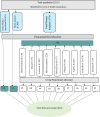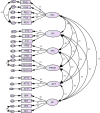Health care professionals intention to use digital health data hub working in East Gojjam Hospitals, Northwest Ethiopia: Technology acceptance modeling
- PMID: 40373078
- PMCID: PMC12080794
- DOI: 10.1371/journal.pone.0322460
Health care professionals intention to use digital health data hub working in East Gojjam Hospitals, Northwest Ethiopia: Technology acceptance modeling
Abstract
Background: Digital health data hubs contribute significantly to finding the right solutions to health problems, which forms the basis for achieving sustainable development goals. However, in Ethiopia, the health system has been coming to one central hub for all data, there is limited evidence of health professionals' intentions to use these systems. Understanding their intentions is crucial, as this can significantly improve the advancement of digital health in healthcare organizations. This study assessed health professionals' intention to use digital health data hubs in hospitals in East Gojjam, northwest Ethiopia, in 2024.
Methods: A cross-sectional study design was used to conduct the study. Eleven hospitals were included in the study area. Using an a priori structural equation modeling sample size calculator, the total sample size was 616. Stratified proportional allocation sampling was performed. The study participants were selected using a systematic sample. Structural equation modeling (SEM) was used for the analysis. Because it is a more powerful multivariate technique for testing and evaluating multivariate causal relationships. The assumptions of SEM-like normality, average variance extracted (AVE), composite reliability (CR), Cronbach's alpha, confirmatory factor analysis (CFA), and model specifications were checked using Amos and Stata version 16.
Results: This study was conducted with a sample size of 616 healthcare professionals; 591 (95.94%) responded to the survey. The results showed that 57.69% (n = 341) of the healthcare professionals intended to use the digital health data hub. Further analysis showed that perceived usefulness (PU: β = 0.576, p = 0.000), perceived trust (PT: β = 0.116, p = 0.022), and attitude (β = 0.143, p = 0.043) significantly and positively influenced health professionals' intention to use digital health data hubs.
Conclusion: Overall, the findings showed that 42.31% of health professionals have low intention to use digital health data hubs. These shall be needed to improve their intentions to use digital health data hubs through targeted interventions. Therefore, focusing on critical factors, such as perceived usefulness, trust, and attitude are crucial factors to reinforce their intention to use the system. Additionally, overcoming implementation challenges and building trust is critical to the successful integration and use of digital health data hubs.
Copyright: © 2025 Gebeyew et al. This is an open access article distributed under the terms of the Creative Commons Attribution License, which permits unrestricted use, distribution, and reproduction in any medium, provided the original author and source are credited.
Conflict of interest statement
The authors have declared that no competing interests exist.
Figures




Similar articles
-
Understanding the predictors of health professionals' intention to use electronic health record system: extend and apply UTAUT3 model.BMC Health Serv Res. 2024 Aug 3;24(1):889. doi: 10.1186/s12913-024-11378-1. BMC Health Serv Res. 2024. PMID: 39097725 Free PMC article.
-
Healthcare Professionals' Attitude to Using Mobile Health Technology and Its Associated Factors in a Resource-Limited Country-An Implication for Digital Health Implementers: A Cross Sectional Study.Biomed Res Int. 2024 Jul 12;2024:1631376. doi: 10.1155/2024/1631376. eCollection 2024. Biomed Res Int. 2024. PMID: 39035773 Free PMC article.
-
Health professionals' technology readiness on the acceptance of teleradiology in the Amhara regional state public hospitals, northwest Ethiopia: Using technology readiness acceptance model (TRAM).PLoS One. 2024 Mar 28;19(3):e0301021. doi: 10.1371/journal.pone.0301021. eCollection 2024. PLoS One. 2024. PMID: 38547241 Free PMC article.
-
Predicting healthcare professionals' acceptance towards electronic personal health record systems in a resource-limited setting: using modified technology acceptance model.BMJ Health Care Inform. 2023 Mar;30(1):e100707. doi: 10.1136/bmjhci-2022-100707. BMJ Health Care Inform. 2023. PMID: 36878620 Free PMC article.
-
Evaluating digital literacy of health professionals in Ethiopian health sectors: A systematic review and meta-analysis.PLoS One. 2024 May 16;19(5):e0300344. doi: 10.1371/journal.pone.0300344. eCollection 2024. PLoS One. 2024. PMID: 38753843 Free PMC article.
References
-
- Otto B. The evolution of data spaces. In: Designing data spaces: the ecosystem approach to competitive advantage. Cham: Springer International Publishing; 2022. p. 3–15.
-
- Mineral. The evolution of data storage. 2022. [Online]. Available from: https://medium.com/viamineral/the-evolution-of-data-storage-5cd4c2c5ef05.
-
- SolarWinds Worldwide. The history of computer data storage, in pictures. Available from: https://www.pingdom.com/blog/the-history-of-computer-data-storage-in-pic...
-
- World Health Organization. Global diffusion of eHealth: making universal health coverage achievable. Report of the third global survey on eHealth. Geneva: WHO; 2016. ed, 2021.
-
- World Health Organization. Global diffusion of eHealth: making universal health coverage achievable: report of the third global survey on eHealth. Geneva: World Health Organization (in en); 2016.
MeSH terms
LinkOut - more resources
Full Text Sources

